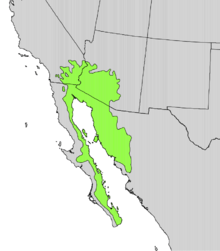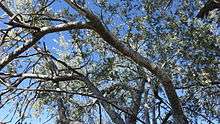Olneya
| Olneya | |
|---|---|
 | |
| Scientific classification | |
| Kingdom: | Plantae |
| (unranked): | Angiosperms |
| (unranked): | Eudicots |
| (unranked): | Rosids |
| Order: | Fabales |
| Family: | Fabaceae |
| Subfamily: | Faboideae |
| Tribe: | Robinieae |
| Genus: | Olneya A. Gray |
| Species: | O. tesota |
| Binomial name | |
| Olneya tesota A.Gray, 1854[1] | |
 | |
| Natural range | |

Olneya tesota is a perennial flowering tree of the Fabaceae family, legumes (peas, beans, etc.), which is commonly known as ironwood or desert ironwood. It is the only species in the monotypic genus Olneya. This tree is part of the western Sonoran Desert complex in the Southwestern United States, which includes flora such as palo verde, saguaro, ocotillo, brittlebush, creosote bush, and mesquite.
Description
The desert ironwood grows as a bush or tree and reaches heights of about 10 metres (33 ft), and average trunk diameters of about 60 cm (24 in); in exceptional sites in larger protected washes, greater height and more massive.
In younger trees, the bark is gray, shiny, and smooth; in older trees the bark is broken open. The tree is an evergreen plant, but can lose its leaves if temperatures fall below 2 °C (36 °F). In continual drought conditions leaves will be lost.
Leaves are bluish-green and pinnately compound. Leaves are arranged on a petiole, 6 in (15 cm) long, with 6-9 leaflets-(or variously up to 15, 7, 7-opposite, and one terminal), each being 0.7 to 2.5 cm (0.28 to 0.98 in). At the base of each pinnate leaf petiole grow two thorns, about 1 cm (0.39 in) long.
Bloom time occurs in late April/May to June. Flowers are of 5 unequal petals, in colors of medium purple, magenta-red, or also white to pale pink. Seedpods are 5–8 cm (2–4 in) long, and light reddish brown. When seedpods are ripened two other species Parkinsonia florida-(Blue Palo Verde), and Acacia constricta-(Catclaw Acacia) have similar light red brownish colors. Catclaw acacia seedpods are noticeably J-shaped and of shorter length.
Range and location
The desert ironwood, Olneya, is native to the southwestern United States and extreme northwestern Mexico in the Baja California Peninsula and the Sonoran Desert, and is partially an indicator species of that desert. Within Mexico its range includes the states of Baja California Sur and Baja California, on the Gulf of California side east of the cordillera ranges, and Sonora state west of the Sierra Madre Occidental cordillera, in the south approaching the northern border of northern Sinaloa state. In the southwestern US its range includes the Colorado Desert of southeast Southern California, a part of the Sonoran Desert, and western and southern Arizona. Olneya does not range into the higher-elevation, colder, southeast of Arizona's Sonoran Desert region, nor into the sky islands of the Madrean Sky Islands region.
Ironwood Forest National Monument in south-central Arizona is named for Olneya tesota.
An indicator species

(the mature, smooth white-gray tree trunk & branches are visible)
Olneya tesota is an indicator species of the Sonoran Desert region.[2] The Sonoran Desert has one other species with the identical north-south, and east-west range. The seasonally migrating Lesser Long-nosed Bat follows the bloom season of various species from south to north and extends into the same regions of the Sonoran Desert as Olneya; (their ranging maps are virtually identical). The bat ranges from southern Baja California del Sur and north into the southwestern United States.[3]
In the north, both species define the Colorado Desert subregion of the Sonoran Desert surrounding the northern end of the Gulf of California; further south in the Baja Peninsula the sub-division is defined as the Vizcaino Desert.
The winter and permanent range of the bat extend into the northern countries of Central America.
Use and workability
Olneya ironwood is very hard and heavy. Its density is greater than water and thus sinks; it does not float downstream in washes, and must be moved by current motion. One popular usage for the wood is for knife handles, since its hardness, grain, and coloring is ideal.
Due to its considerable hardness, processing desert ironwood is difficult. Final treatment of the wood with solutions can also be difficult because of its high density.
See also
| Wikimedia Commons has media related to Olneya tesota. |
References
- ↑ "Olneya tesota A. Gray". Germplasm Resources Information Network. United States Department of Agriculture. 2007-05-14. Retrieved 2009-10-13.
- ↑ Atlas of United States Trees, Volume 3, Minor Western Hardwoods, Map 103-Olneya tesota
- ↑ Bat range, and article
Further reading
- Little. Atlas of United States Trees, Volume 3, Minor Western Hardwoods, Little, Elbert L, 1976, US Government Printing Office. Library of Congress No. 79-653298. Map 103, Olneya tesota.
External links
- {http://www.calflora.org/cgi-bin/species_query.cgi?where-calrecnum=5914 Calflora Database: Olneya tesota (desert ironwood, ironwood)]
- Jepson Manual eFlora (TJM2) treatment for Olneya tesota
- USDA Plants Profile of Olneya tesota (desert ironwood)
- UC Photos gallery — Olneya tesota
- Lesser Long-nosed Bat Ranges — equal to Olneya tesota: